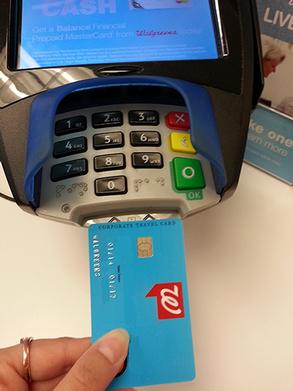DEERFIELD, Ill., 2015-9-30 — /EPR Retail News/ — Credit cards with “EMV chips” are now being accepted at all of the more than 8,200 Walgreens retail stores nationwide, ahead of the Oct. 1 deadline for retailers to begin accepting the new cards.
Most financial institutions and card issuers are sending their customers chip cards that require signatures for verification, rather than PINs. While both types of cards improve security, PINs protect against forged signatures and are more secure. Most major retailers, including Walgreens, will be equipped to accept PINs or signatures and are urging card issuers to offer customers chip-and-PIN technology (see below for more detail on chip-and-PIN versus chip-and-signature technology).
Walgreens began transitioning stores to the new technology more than three years ago when it installed new point-of-sale terminals. The company was able to complete its preparation for chip cards this year with the retail and financial industries’ adoption of standards for chip card acceptance. The upgrade involved approximately 60,000 point-of-sale terminals in 8,200 stores.
The following are some commonly asked questions regarding the technology:
Q. How do the new chip cards differ from older credit cards?
A. U.S. financial institutions and card issuers are in the process of sending their customers new cards with EMV technology. EMV stands for Europay, MasterCard and Visa. The cards contain a gold or silver metallic square chip visible on the front. Older cards with magnetic strips contain data that can be stolen or replicated. Chip cards create a new transaction code for each purchase and the code cannot be reused. European card issuers have been using the chip technology for years now and successfully reduced incidents of counterfeit fraud as a result.
Q. What if I do not have a chip card?
A. Even after the transition to chip cards, Walgreens stores will continue to accept older magnetic strip swipe cards as well as chip-and-pin and chip-and-signature cards.
Q. What does the customer need to do differently?
A. Instead of swiping the magnetic strip, the card is inserted in a slot at the terminal during the payment process and left there until a screen prompt tells you what to do next. Depending on the card you carry and the transaction amount, you may be asked to provide a PIN or signature.
Q. Will you accept debit cards with chips as well as credit cards?
A. At present, debit cards with chips may be used for purchases at Walgreens, but customers are asked to swipe them instead of inserting them in the chip-card slot. After a transition period of a few weeks, Walgreens customers will be able to insert their debit chip card in chip readers except in cases where they wish to receive cash back. Customers requesting cash back will still have to “swipe” their cards the old way. By next year, debit card users requesting cash back also will use the chip card readers.
Q. Are Walgreens employees trained and ready?
A. Information and training has been provided to Walgreens employees, and they have additional information available in the store in case questions come up. The point-of-sale system has simple prompts that make transactions straightforward.
Q: What is the difference between chip-and-signature and chip-and-PIN transactions?
A. Both types of transactions use the same EMV chip cards. Chip-and-signature transactions only require your signature, while chip-and-PIN transactions require you to enter your card’s PIN on the terminal.
Q. Isn’t chip-and-PIN the most secure card transaction?
A. Chip transactions are more secure than magnetic strips, and chip-and-PIN are the most secure. Unfortunately, a number of credit card issuers will only process less-secure chip-and-signature transactions. That means your card remains more susceptible to lost and stolen fraud simply by forging your signature. A PIN used with the chip card significantly reduces the possibility of that form of fraud. Retailers, including Walgreens, committed significant resources to build chip-and-PIN infrastructure at points of sale all across America. Now is the time for card issuers to make full use of this important consumer protection technology.
About Walgreens
Walgreens (www.walgreens.com), the nation’s largest drugstore chain, is included in the Retail Pharmacy USA Division of Walgreens Boots Alliance, Inc. (Nasdaq: WBA), the first global pharmacy-led, health and wellbeing enterprise. More than 8 million customers interact with Walgreens each day in communities across America, using the most convenient, multichannel access to consumer goods and services and trusted, cost-effective pharmacy, health and wellness services and advice. Walgreens operates 8,240 drugstores with a presence in all 50 states, the District of Columbia, Puerto Rico and the U.S. Virgin Islands. Walgreens digital business includes Walgreens.com, drugstore.com, Beauty.com, SkinStore.com and VisionDirect.com. Walgreens also manages more than 400 Healthcare Clinic and provider practice locations around the country.
To contact Walgreens media relations, please email media@walgreens.com or call 847-315-2921.
###
